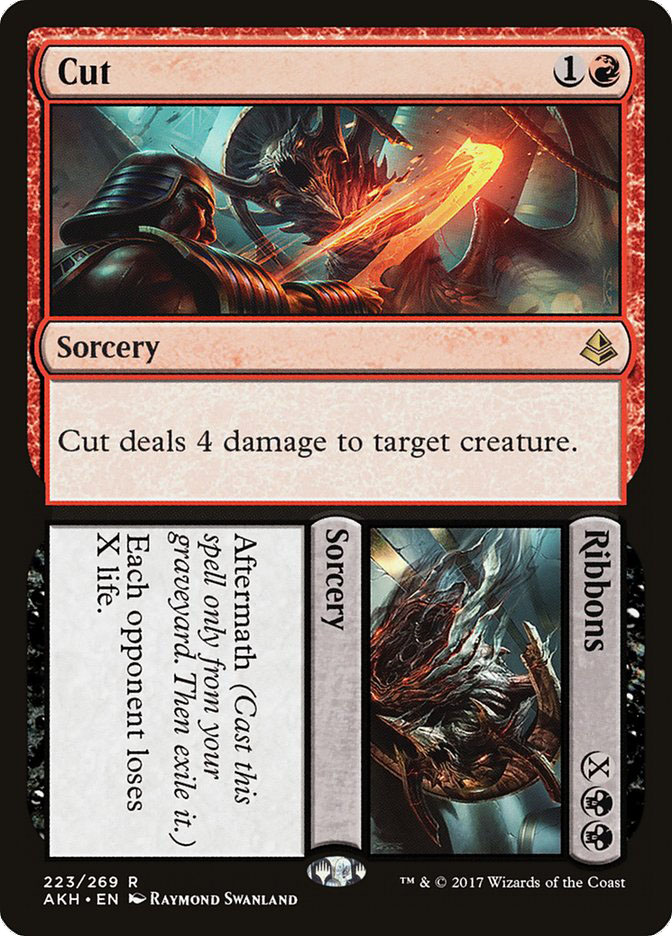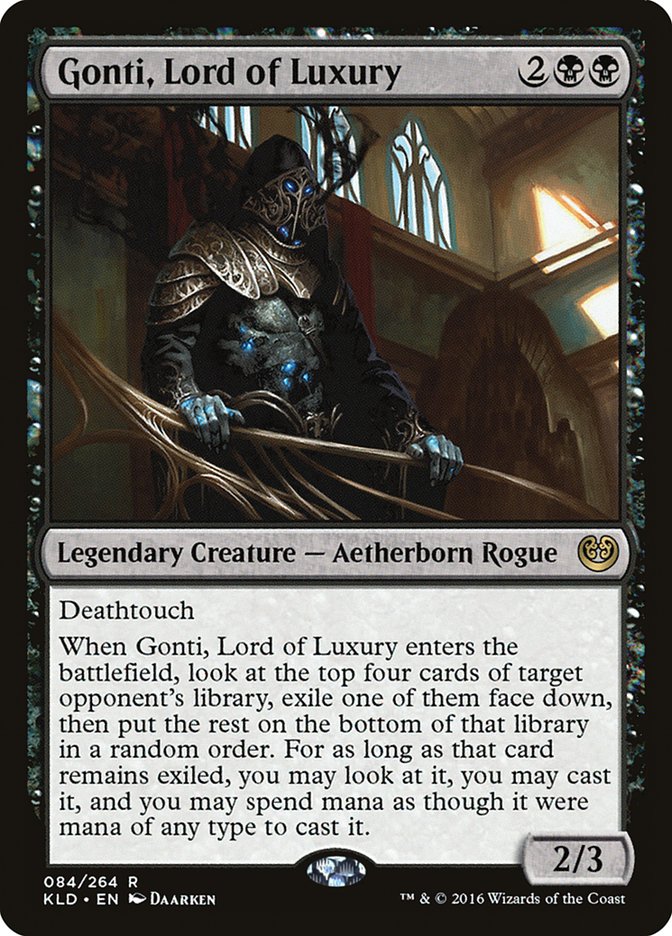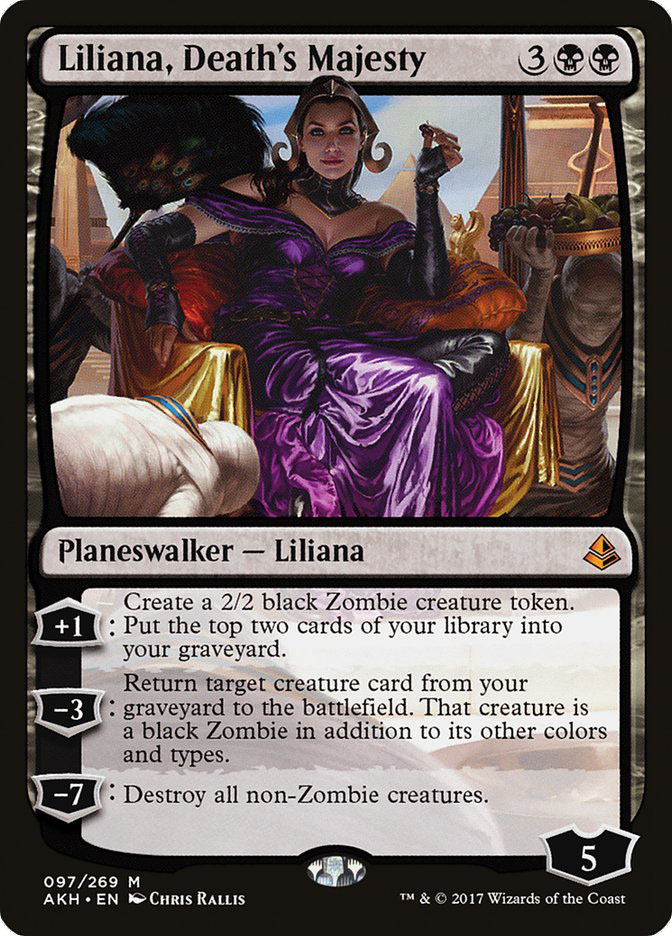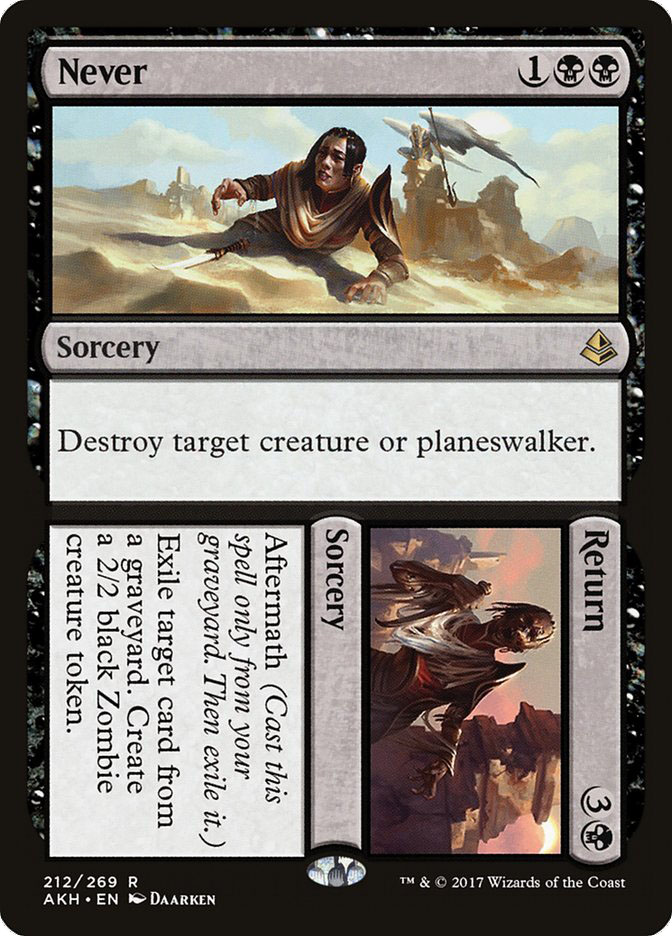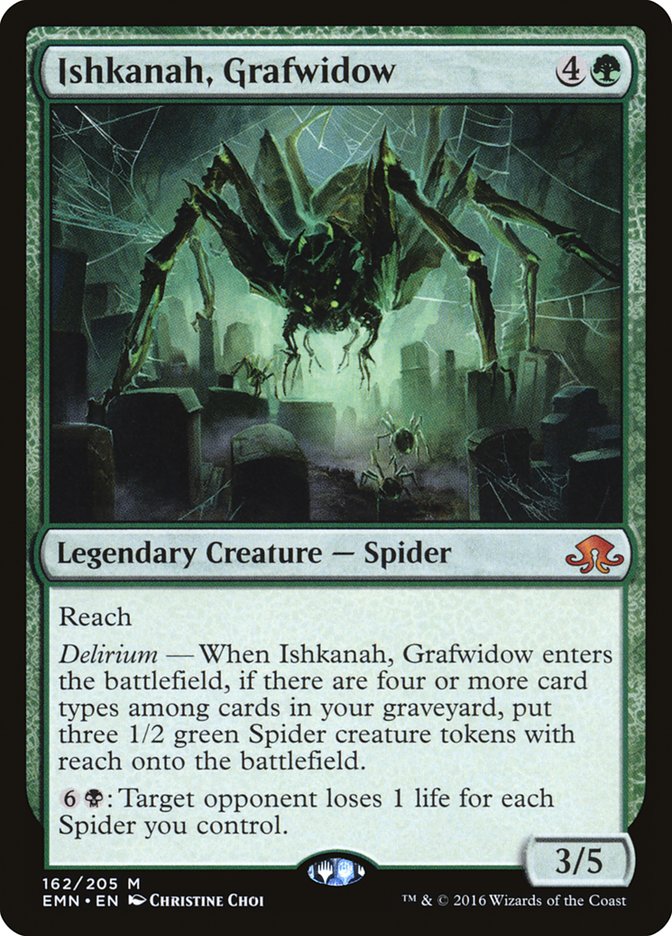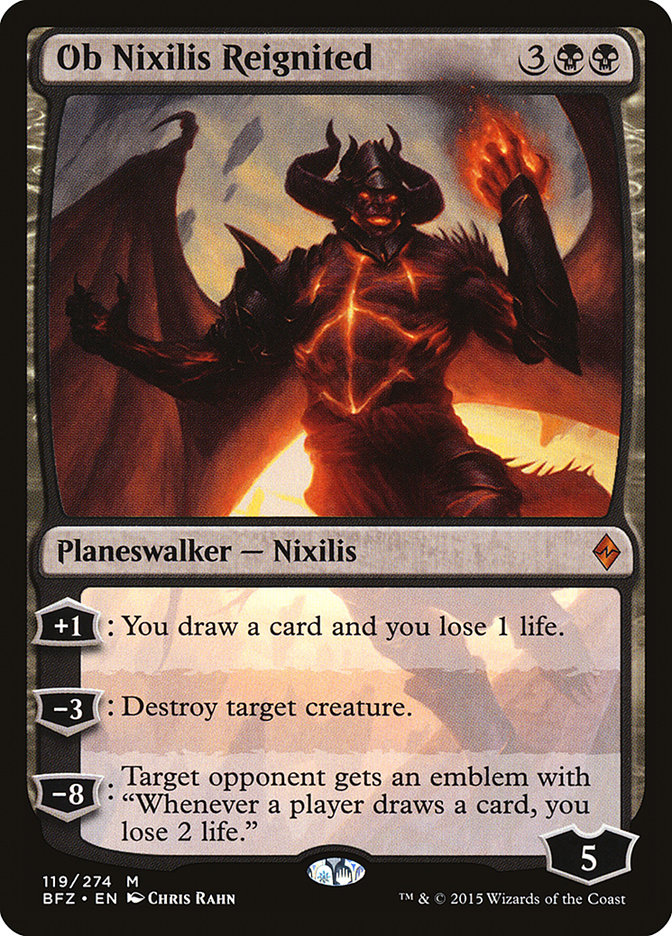Back on top!

Todd Stevens, Jim Davis, and Eli Kassis, eat your heart out!
New Standard has been everything I’ve hoped it was and more. This past weekend was the most excited I’ve been walking into a tournament hall since my first Pro Tour, the inaugural tournament for Modern in Philadelphia. Fresh bannings, limited testing time, new set, old favorites! The story might have been all Mardu Vehicles at the end of the day, but I certainly believe that we’re only knocking at the door of what this format has to offer.
We had a Gideon, Ally of Zendikar flavor to the Top 8 here at the debut of Amonkhet, and with five copies in the elimination rounds, it’s no surprise it took down the trophy, and in the hands of a very skilled Magician, I might add.
Creatures (18)
- 2 Archangel Avacyn
- 4 Thraben Inspector
- 2 Thalia, Heretic Cathar
- 4 Scrapheap Scrounger
- 4 Toolcraft Exemplar
- 2 Walking Ballista
Planeswalkers (4)
Lands (20)
Spells (18)

To say that there was a ton of innovation to this archetype would be an overstatement, but that’s not necessarily a bad thing. With only one real day of testing available for this format, taking a deck that has proven time and time again to have the best and most resilient aggressive starts the format has to offer, while bringing an insane transformative sideboard plan to the table that most decks have difficulty sideboarding to fight, was a perfect formula for a brand new format.
One addition to Mardu that Andrew Jessup made to the deck that he mentioned lamenting not having an additional copy of in his maindeck was Cut//Ribbons. While on the surface Cut//Ribbons is merely an awkward sorcery-speed removal spell with some limitations for what it can kill, in Mardu Vehicles, gaining access to a “free” Fireball effect to help close out games that might have started to slip away from them is absurd. Going forward, I would definitely expect there to be at least two copies of Cut//Ribbons maindeck with the potential for a third in the sideboard in matchups that go long.
Once again, big congrats to Andrew Jessup for taking down a trophy! I would have loved to have a rematch of our inconclusive Round 9 in the finals, but I fell short of such a story line.
So with that, did I end up sleeving up Mardu Vehicles for SCG Altanta? Well, this time I went way in left field, completely out of my comfort zone, using tons of new cards, playing something completely untested and nothing what anyone expected!
Creatures (15)
- 2 Tireless Tracker
- 2 Ishkanah, Grafwidow
- 4 Grim Flayer
- 2 Gonti, Lord of Luxury
- 1 Noxious Gearhulk
- 3 Walking Ballista
- 1 Manglehorn
Planeswalkers (4)
Lands (17)
Spells (24)

Okay…. I lied.
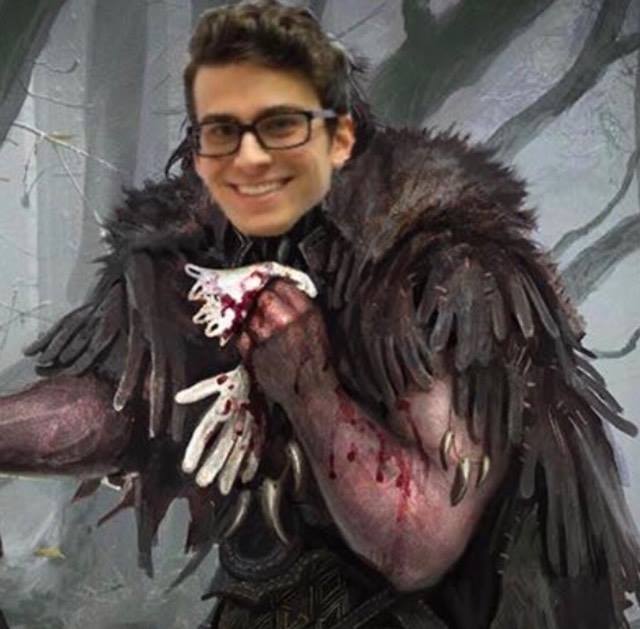
What can I say? I love me some Grim Flayer.
In all seriousness, with the lack of preparation time given for this event and my overall familiarity with the Delirium decks we’ve had available to us since the release of Eldritch Moon, plus the recent banning of a slightly unfavorable matchup that was the Felidar Guardian / Saheeli Rai combo, this was an easy choice for me. What was difficult to figure was the exact configuration of which tools I wanted to have access to from the Standard B/G arsenal.
Some of the less obvious choices for a controlling deck such as this variation of Delirium have been brought into question by numerous people, most notably Gonti, Lord of Luxury and Walking Ballista.
Gonti, Lord of Luxury has often been relegated to the sideboards of many B/G Delirium decks, even showing up in the more aggressive builds as well. My decision to play this card in the maindeck was because I believed the mirror to be a little more prevalent than it ended up being.
While many cards such as Liliana, Death’s Majesty and Tireless Tracker are very good in the mirror match, Gonti, Lord of Luxury is perhaps the best of them all. Many mirror matches come down to the long grind and nothing is as good as stealing cards from your opponent’s deck and using them against your foe. Gonti blocks actually everything and finds its way to the graveyard to be recurred at a later time.
Against a slow control deck, Gonti, Lord of Luxury is a must-counter threat despite it not looking all that threatening on the surface. The impact of stealing a critical counterspell such as Disallow, Essence Scatter, or Negate could potentially end the entire game. Nothing feels better than Essence Scattering a Torrential Gearhulk that’s attempting to ambush you in combat when they think the coast is clear.
Walking Ballista is the other card I received a lot of flak for with its inclusion in my deck, especially since I didn’t play Winding Constrictor or Verdurous Gearhulk. While Walking Ballista is certainly amplified with Winding Constrictor and Verdurous Gearhulk, Walking Ballista is a flexible removal spell in disguise that functions as a mana sink and Fireball with excess mana available. Pinging down any number of one-toughness creatures for four mana might not be the most efficient way of killing creatures, but it gets the job done, and it makes combat math miserable for opponents as they go through what-if scenarios.
One of my most controversial choices was to play three copies of Liliana, the Last Hope rather than Liliana, Death’s Majesty in my maindeck. I do recognize the power level of Liliana, Death’s Majesty against a bevy of opponents, including the mirror match; however, in a sea of Mardu Vehicles, Humans, Zombies, and even control decks, I’d much rather have Liliana, the Last Hope.
Her ability to manage the early game cannot be understated. Paired with Grim Flayer and Tireless Tracker, you can push through damage and build toward delirium very quickly, managing the game throughout. If I could begin every game with a Vessel of Nascency putting an Ishkanah, Grafwidow into my graveyard and a Liliana, Death’s Majesty to my hand while also facilitating delirium, I’d agree that Liliana’s five-mana variant would be superior. However, we live in the real world where that is not always the case and the efficiency and versatility of Liliana, the Last Hope make me believe it’s still the superior of the two.
One card that overperformed for me all weekend was Never//Return. With less need to interact at instant speed and the Mardu Vehicles plan of becoming a Planeswalker Midrange deck, “1BB: Destroy target creature or planeswalker” has never been as good.
But Never//Return is so much more than that. While the back half is overcosted for its effect by a wide margin, much like the back half of Cut//Ribbons, it’s an entirely free effect you have access to. You even have the potential to flip it over while finding a card with Vessel of Nascency, giving you even more added value.
Cards of value I exiled with Return this past weekend include a Glimmer of Genius that would’ve been a Torrential Gearhulk target, Prized Amalgam, an opposing Never//Return, a lethal Cut//Ribbons, Stitchwing Skaab, Scrapheap Scrounger and its food, and Ishkanah, Grafwidow with a Liliana, Death’s Majesty looming. This format has a lot of recursive elements, and being able to throw a wrench in the opponent’s plan while gaining even a lowly 2/2 Sam Black Zombie token can make all the difference.
No one is perfect, and my list certainly is not; it was built with a completely unknown Standard metagame to answer. The best way to win in Magic is to be proactive and this deck seemingly does very little of that. While there are games that play out that way and you are by no means the aggressor against most opponents, you still have the potential to lead on a copy of Grim Flayer or Tireless Tracker backed by removal spells, and you could find yourself signing the slip in short order.
Ishakanah, Grafwidow has been given a breath of new life in Standard with the release of Amonkhet. While supremely defensive at face value, Ishkanah, Grafwidow is often a highly proactive play when it comes to checking or fighting for the battlefield. Mardu Vehicles can answer a lot of threats and they often don’t mind their threats being answered, yet Ishkanah, Grafwidow gives them fits like no other card. Why is that?
It’s because Ishkanah, Grafwidow does neither of those things. This legendary Spider doesn’t actually answer threats; she simply invalidates them entirely. With the time that Ishkanah, Grafwidow buys you by invalidating most of what your opponent is doing in any given game, you can find ways to win through the inherent card advantage the majority of your cards generate given enough time and mana. I’m happy that I can once more assemble a Spider army in Standard without much fear of dying on the spot.
It will be a month or so with endless Magic Online results, as well as a Pro Tour I hopefully get to help shape, before Standard comes back to the SCG Tour at the Invitational. That being said, the above-mentioned Pro Tour next week is something I’d like to do well at! SCG Atlanta taught me some things about the format and with online being my primary means of testing, I’ve been constantly looking for ways to improve my list and have settled here for now.
Creatures (14)
- 2 Tireless Tracker
- 2 Ishkanah, Grafwidow
- 4 Grim Flayer
- 1 Gonti, Lord of Luxury
- 1 Noxious Gearhulk
- 3 Walking Ballista
- 1 Manglehorn
Planeswalkers (4)
Lands (23)
Spells (19)

Long has Ob Nixilis Reignited been somewhat of a signature card for me as a maindeck inclusion, but with the decline of decks such as B/G Winding Constrictor, I believe the mighty Planeswalker’s time has passed. One copy of Liliana, Death’s Majesty seems like a fine complement to the deck, hopefully rebuying Ishkanah, Grafwidow against a removal-heavy draw out of Mardu Vehicles.
Never//Return was probably the best card I played all weekend, answering Public Enemy #1 Gideon, Ally of Zendikar. Adding another copy to the maindeck over a Gonti, Lord of Luxury should help even more with how the metagame is, while still keeping one in the mix as a Traverse the Ulvenwald target for Game 1.
The reason I believe that B/G Delirium is a fantastic deck for this Standard metagame is because of its efficiency. You’ll note that only five cards cost more than four mana in this updated list. If we’ve learned anything from older formats, it’s that efficiency is king. Efficiency also leads to complexity, since it gives you numerous options every turn of the game. While every deck you play in Magic is likely to require a large amount of skill, I do believe this deck is more punishing for unfamiliarity than most others.
Magic isn’t something that’s cut and dried when it comes to almost any aspect of it especially sideboarding. I played against Mardu Vehicles eight times throughout the Swiss rounds of SCG Atlanta and all of them brought in a more midrange package for Games 2 and 3. That doesn’t mean they’re not capable of eschewing that plan and being the beatdown if on the play, making what to have against them all the more difficult. Here’s a general sideboarding guide for common matchups.
Mardu Vehicles
Out:
In:
You want the most possible ways to deal with a turn 4 Gideon, Ally of Zendikar or other random planeswalker. Walking Ballista loses a lot of its luster when they remove Toolcraft Exemplar from the equation, but it’s nice to be able to find in a pinch with Traverse the Ulvenwald. The game goes long, so Tireless Tracker helps you keep up with some of their potential card advantage cards like Painful Truths.
U/R and Jeskai Control
Out:
In:
If you’re playing against a deck with more artifacts and enchantments other than just Torrential Gearhulk, such as Cast Out, Fevered Visions, Drake Haven or Dynavolt Tower, then feel free to bring in the additional Appetite for the Unnatural over another Walking Ballista. Same goes for Manglehorn if it’s artifacts you’re after.
Out:
In:
This might be the deck’s worst conceivable matchup, but that doesn’t mean it’s unwinnable. Long gone are the days where they have Emrakul, the Promised End. You have to be the beatdown in this matchup, and while you do sideboard out your situational removal, you’ll still need ways of killing their sideboarded Tireless Trackers or you can just fall behind and never be able to catch up with a decent draw from them. Don’t overload on ways to kill Aetherworks Marvel; with Traverse the Ulvenwald and two Manglehorn, you’ll only need one Appetite for the Unnatural. The key to winning this matchup is stripping them of Ulamog, the Ceaseless Hunger before they get to cast it.
Zombies
Out:
In:
This is a matchup that can go either way, from my experience. If your removal lines up and Liliana, the Last Hope comes down in a reasonable time frame you’ll be fine. Kalitas, Traitor of Ghet is almost exclusively for this type of matchup, since their recursion going long is too much for even Ishkanah, Grafwidow to handle.
The Mirror
Out:
In:
Not too much here. Grim Flayer has a lot of diminishing returns as the game goes late, since it’s not one of the cards that matters on a stalled battlefield. With upwards of thirteen ways to kill an opposing Grim Flayer before it gets out of hand, I don’t mind sideboarding out a couple. The additional Ishkanah, Grafwidow isn’t necessary here. You only need one and you’ll have plenty of ways to recur it if need be. Gonti, Lord of Luxury shines here in the ways I wrote about before, as does Tireless Tracker in a similar sense if left unchecked.
There’s a lot to explore still in the week leading up to Pro Tour Amonkhet. B/G Delirium is where you’ll likely see me end up for that event because of my familiarity with the deck, but we’ll see in the few days available if something emerges from the scourge that is the Magic Online 5-0 decklists. I’m more excited for Standard than I have been in a very long time and I look forward to seeing where the Pro Tour takes us!


